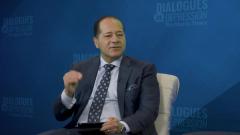
Navigating Major Depressive Disorder (MDD): The Role of Glutamate
Experts discuss the significance of glutamate in major depressive disorder, highlighting its links to neuroplasticity and stress.
Episodes in this series

Transcript
Gus Alva, MD, DFAPA: Welcome to this Psychiatric Times presentation titled, “Bridging the Gap in Major Depressive Disorder Care: Rapid-Acting Therapies and Glutamine. I’m Gus Alva. I’m the founder and medical director of ATP Clinical Research in Orange County, California. I am thrilled to be joined today by Craig Chepke, a board-certified psychiatrist at Excel Psychiatric Associates in Huntersville, North Carolina. We’ve got Greg Mattingly, a physician and principal investigator in clinical trials for Midwest Research Group in St. Charles, Missouri. Last but not least, Erin Crown, a certified physician assistant and managing member at Oasis LifeCare in State College, Pennsylvania. In today’s discussion, we will focus on the role of rapid-acting therapies, specifically NMDA receptor modulators, in the management of major depressive disorder. Our conversation will explore the mechanisms that distinguish rapid-acting treatments from traditional antidepressants and major depressive disorder management and foster a better understanding of treatment-resistant depression, and strategies for addressing it. Lastly, we will examine real patient cases, emphasizing the importance of considering individual patient experiences and tailoring care accordingly. Let’s begin. If we consider the fact that glutamate and its presence in the brain is heavily concentrated in different regions like the cortex, cerebellum, hippocampal region, thalamic nuclei, caudate nucleus, which one of you wants to lead off by telling us why it is that glutamate is where it is in the brain? Why does that matter?
Greg Mattingly, MD: Glutamate’s the main excitatory chemical in the brain. For neural networks to turn on, glutamate pretty much has to fire. And, Craig, I think it’s like 98% of our synapses are modified by glutamate neurotransmission. The analogy I use quite a bit is it’s kind of like the gas pedal in your car. You can turn on the key, but if the gas pedal doesn’t go, you’re not going to get where you need to be. Glutamate turns on those neural networks and helps them to fire.
Gus Alva, MD, DFAPA: Interesting.
Craig Chepke, MD, DFAPA: To say where glutamate is in the brain, it’s everywhere. I mean, the whole cortex runs off of glutamate. It’s a glutamate machine, basically. That’s what does the work of the brain.
Gus Alva, MD, DFAPA: Erin, your thoughts on that?
Erin Crown, MHS, PA-C: A little bit of a different direction. It’s heavily influenced by stress, and we know that we all have a lot of stress in our lives in various ways, and it’s impacted by that. So, bottom line: It’s everywhere and highly impacted by stress and inflammation.
Greg Mattingly, MD: Erin said something that’s fascinating, and this is why I went into psychiatry over 30 years ago. Glutamate starts that whole cascade of neural plasticity. So it’s a key component of turning on neural networks, but not just turning on your neural networks, but turning on the ability to survive under stress. Without that, our brain isn’t plastic. It doesn’t grow. It doesn’t sprout. It doesn’t connect with each other. So we’re turning on neural networks. We’re turning on neural plasticity. We’re allowing nerve cells to reach out and grow and connect with each other, especially in times of stress.
Transcript was AI-generated and edited for clarity.
Newsletter
Receive trusted psychiatric news, expert analysis, and clinical insights — subscribe today to support your practice and your patients.






























